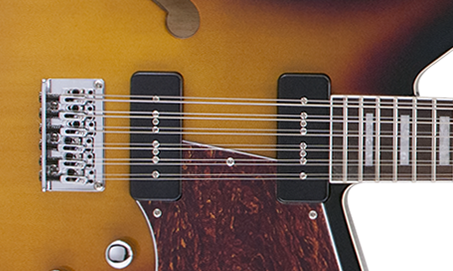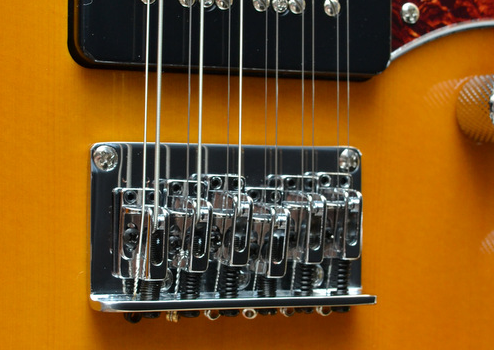12-String electric guitars have a charm like no other. Although they may be most strongly associated with the sound of 1960s pop-rock, their bright, distinctive tone can also be found in modern indie rock, classic blues and countless other genres. They provide a sound that is instantly recognizable and just can’t be replicated artificially. But unfortunately they also don't seem to get a lot of attention. It's not uncommon for guitar players to have multiple 6 strings around their house, plus maybe a bass or two, but how many people do you know who own and love a 12-String? So this week we’re going to try to fix that by taking a look at the Reverend Airwave. We’ll take a look at the instrument itself as well as the basic principles of 12-Strings in general and what makes them worth having around.
A quick note about octaves
Before we can really talk in depth about a 12-String guitar we first need to talk about octaves. For players more experienced in music theory this will all be old news, but it’s an important concept to grasp.
So, as we know, all sound is caused by vibration and it’s the speed of that vibration that determines what pitch (or note) we hear. The unit of measure we use to describe this vibration is the Hertz. 1 Hertz is a full wave per second. For example, A string of a guitar is normally tuned to be at exactly 110 hertz, meaning that the string vibrates back and forth exactly 110 times per second.
When we say the word octave what we mean is that it’s a note vibrates air at either half or twice the speed of another note. So for example, let’s look at the A string on your guitar again. If you pluck the string without fretting any notes on the fretboard you’re going to hear an A note ringing out at 110hz. Now, if hold the string down at the 12th fret and pluck you’re going to also hear an A, but this time it will be vibrating at 220hz. So the second A (the one at the 12th fret) is 1 octave higher than the open A.
So what is a 12 string?
What makes a twelve string different from a standard 6 string is it’s use of these octaves. On a regular 6 string guitar in “Standard” tuning, each string is tuned to it’s own unique pitch and each note is higher than the preceding one. Starting with the 6th string, the thickest one, the guitar is tuned E A D G B e, giving us 5 completely unique notes and 1 octave (The reason that the last e is in lowercase is to designate that it’s two octaves higher than the low E string). All of these strings are equally spaced, meaning that no string is farther away from an adjacent string than any other.
With a 12-String, this works a little different. Rather than having 12 equally spaced strings you instead have 6 pairs of strings. Each pair is made up of two strings that are either tuned to octaves of each other or the exact same pitch. So, from low the 6th to 1st, a 12-String’s tuning looks like this : eE aA dD gG BB ee. Both strings in any pair are spaced closely together so that they can both be fretted at the same time using only 1 finger. This means that, unlike a 6 string where 1 string can be plucked at a time, a 12-String player will never strike less than 2 strings at once.
One other quick note about 12-Strings is that they can vary on what string in each pair is on top. On the Airwave, and on most 12-String electrics, the octave string is on the top of each pair, meaning it's the first string to make contact with the pick when making a downstroke. Having the octave string on the bottom is less common, although not completely unheard of. Here you can get a closer look at octave on top setup:

Now that we know basically how a 12-String guitar is designed we can move on to what makes them so cool.
The Sound
The defining quality of the 12-String Airwave is its “shimmering” tone. When strummed a 12-string has rich, complex overtones along with a sort of bright jangle. This sound has been described in a lot of different ways, with some people thinking it sounds almost orchestral while others hear it as bell like. No matter what word they’re using what they’re really describing is a “Chorus” effect.
No two strings are ever going to vibrate simultaneously. Even when tuned to the same pitch, they will end up being “out of phase”, meaning that one string may be going up when the other is still going down or vice versa. This is what causes the “Shimmering” quality of the a 12-String, as the two strings in a pair create interference for each other, making them sound ever so slightly out of tune although still very musical. It also causes sustained notes played on a 12 string to seemingly fluctuate in volume as they are held, giving the sound a warbly sound.
In practice this gives the Reverend Airwave a fantastic full sound for rhythm playing. It fills in more of the tonal spectrum, both from the principle tone of the additional strings as well as the harmonics created as each pair of strings vibrates together. Combine this with with Reverend’s CP90 pickups and their tried and true bass contour knob and you’re left with a surprisingly versatile sound. It’s a cinch to dial in the vintage 60’s rock 12-String tone if that’s what you want, but it also allows room for experimentation.
Also important to the sound of the Airwave is the construction of it’s body. It’s back and sides are made of Korina, Reverends usual wood of choice. Korina is a bright wood, maybe moreso than Mahogany. And while 12-Strings are traditionally bright guitars it may have sounded to shrill had Reverend used Korina for the entire body. To counteract this they chose to go with a solid Spruce top, which is a more mellow sounding tonewood. It helps to take the edge off of the guitar, keeping the brightness from becoming harsh and helping to provide a more balanced tone.
Playability
The Airwave features a 1-¾” nut, slightly wider than most Reverend guitar necks. This extra space is necessary to accommodate the extra 6 strings. This may end up being a little more difficult for those with smaller hands but the extra width in a necessity for this style of guitar. It also has a short scale length at only 24-¾” long. At first I was worried that this shorter scale would have a negative effect on the upper harmonics but I’m happy to say I haven't notice any. This short scale also makes for a very playable instrument as it helps reduce the tension of the strings, resulting in less fatigue for your fretting hand.
The Bridge
One last thing I’d like to make mention of is the bridge that Reverend is using on the Airwave. While by their very nature an electric guitar with parallel frets is never going to have perfect intonation. Each string will always be a tiny bit out of tune compared to the others. Often this slightly imperfect tuning is unnoticeable. However, when you double the number of strings on your instrument the problem can compound and you end up with very obvious tuning problems.
To combat this Reverend has used a bridge with independent intonation adjustments on each string. Rather than using one saddle for each pair you’re instead able to adjust each individual string. This is a feature that even some of the most wellknown 12-String manufacturers overlook and I’m really happy to see it implemented on the Airwave. It’s not something you’ll think about every time you pick up the instrument but trust me when I say you’ll be happy to have it when setup time comes.

The Reverend Airwave's Bridge with independent saddle adjustment
And that’s it for this week. Are you a 12-String player who has thoughts on the design of the Reverend Airwave? A player who's interested in getting your first 12 string and has some more questions? Be sure to let us know in the comments below.